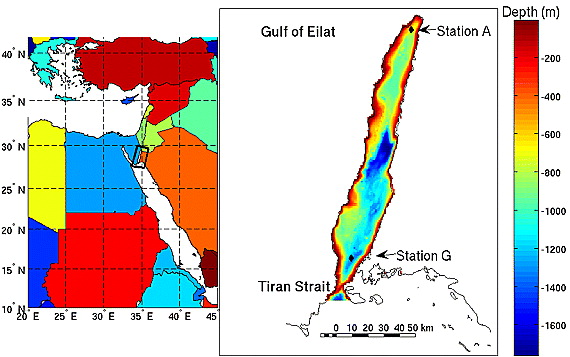
(left) The area of study indicated by the inset, (right) with the gulf bathymetry also shown – source: Biton et al. (2011a)
In three nice papers, Eli Biton (Department of Physics, Israel Oceanographic and Limnological Research, Haifa, Israel) and Hezi Gildor (Institute of Earth Sciences, Hebrew University of Jerusalem), have been using MITgcm to explore the circulation in the Gulf of Aqaba (Gulf of Eilat), a terminal elongated basin that exchanges water with the northern Red Sea via the Straits of Tiran.
General Circulation – Exchange Flow and Surface Flux Interplay
In The general circulation of the Gulf of Aqaba (Gulf of Eilat) revisited: The interplay between the exchange flow through the Straits of Tiran and surface fluxes (Biton and Gildor, 2011c), Biton and Gildor investigate the coupling between the dynamics in the gulf and the exchange flow through the Straits of Tiran in response to seasonally varying surface net heat and fresh water fluxes and northern Red Sea hydrographic conditions. Using MITgcm to investigate the annual cycle of the general circulation and hydrographic conditions in the gulf, they demonstrate that on a subannual time scale, the general circulation deviates from the standard depiction of inverse estuarine circulation. During the restratification season (April–August), the exchange flux with the northern Red Sea is maximal and is driven by density differences between the basins, while atmospheric fluxes actually counteract this exchange flow. The observed warming of the surface layer is mainly due to advection of warm water from the northern Red Sea, with a smaller contribution from surface heating. During the mixing season (September–March), the exchange flux and the advection of heat are minimal and atmospheric fluxes drive convection rather than the exchange flow. They estimate the seasonality of the exchange flow through the Straits of Tiran to be rather large, ranging from 0.04 Sv during early spring to 0.005 Sv during early winter.
Seasonal Restratification and Salinity Evolution
The gulf’s hydrography exhibits strong seasonal variability, with deep mixing in February–March and stable stratification afterward. In Stepwise seasonal restratification and the evolution of salinity minimum in the Gulf of Aqaba (Gulf of Eilat) (Biton and Gildor, 2011a), Biton and Gildor use MITgcm again to explore this strong seasonal variability encountered in the experiments reported in Biton and Gildor (2011c). Here they investigate the restratification process in the surface layer by using the same model configuration but with the aid of passive tracers that allow tracking of water entering through the straits as it flows northward. The pair show that the time-varying surface hydrography in the northern Red Sea has a significant influence on the seasonal hydrographic conditions in the gulf. The northern Red Sea water warms monotonically during the restratification phase and as a result, new water that enters the gulf during this phase is warmer than the water that entered previously and therefore the stratification is built up gradually layer by layer. The simulations also point to the phase difference between minimal salinity (May) and maximal temperature (September) in the northern Red Sea being responsible for the evolution of subsurface salinity minimum level along the gulf as well as explaining the observed transition to a four-layer exchange flow between August and November.
Dynamics of a Strait — Marginal-Sea System
Finally, in The coupling between exchange flux through a strait and dynamics in a small convectively driven marginal sea: The Gulf of Aqaba (Gulf of Eilat) (Biton and Gildor, 2011b), the authors seek to develop a new theory for strait-marginal sea systems such as the Gulf of Aqaba that exhibit strongly seasonally varying hydrography and for which existing theories do not apply. Because the gulf is a relatively small basin, winter mixing between the surface and intermediate layers occurs over most places in the gulf including in the vicinity of the straits, and leads to a maximal exchange flow in the strait. During the spring, warming in the Red Sea forces an influx of warm Red Sea water into the gulf, the surface layer is refilled, and consequently the exchange flow in the straits changes from a maximal to a submaximal flow regime. As a result, the dense wintertime water formation in the gulf and the exchange flow through the strait are strongly coupled on seasonal time scales. In addition, the hydrographic conditions in the northern Red Sea undergo strong seasonality. These characteristics prevent the direct application of current theories for strait-marginal sea systems, which commonly assume steady conditions in the “open ocean” side of the strait and/or an annual mean surface flux over the marginal sea. Based on their experiments, the pair are able to explain why the exchange of volume and heat between the Gulf of Aqaba and the northern Red Sea is larger during spring and summer despite the net surface buoyancy input into the gulf and why it diminishes during fall and winter despite the large buoyancy loss to the atmosphere.
Model Details
The Biton-Gildor model domain included the whole Gulf of Aqaba and ends ~20km south of the Straits of Tiran. The horizontal resolution was 300 m, with 32 vertical levels, most of which were concentrated in the upper ~300 m to capture the complex dynamics in the upper ocean, with a time step of 100 s. Mixing was modeled using “KPP” (based on the local Richardson number). To increase computational efficiency, the model grid was rotated to align the axes of the coordinate system along the length and width of the gulf. The model was run for 15 years until a quasi steady state condition was reached. At the southern end of the domain there was a sponge layer in which temperature and salinity were relaxed to monthly mean profiles. Profiles were based on analysis of temperature and salinity profiles taken from the National Oceanographic Data Center database (http://www.nodc.noaa.gov/). The sponge layer had a width of 6 km (20 grid points) with the relaxation time being gradually increased from 2160 s at the southern end of the sponge layer, to 4320 s at its northern end. For more details see Biton and Gildor (2011c).
Current Projects
Right now Biton and Gildor are using MITgcm to study the paleoceanography of the Red Sea during the Emian (continuing from the two paleoceanography papers on the Red Sea during the LGM and during the Holocene, Biton et al., 2010, Sensitivity of Red Sea circulation to Monsoonal variability during the Holocene: A modeling and sediment record study, and Biton et al., 2008, Red Sea during the Last Glacial Maximum: Implications for sea level reconstruction). They are also using MITgcm to close the energy budget of the Gulf of Eilat, study the sensitivity of the Gulf of Eilat to inter-annual climate variability, and understand the relationship between the open-ocean and Israeli Shelf circulations.
Want to know more? Contact Hezi or Eli
References
Biton, E., H. Gildor, and W.R. Peltier (2008), Red Sea during the Last Glacial Maximum: Implications for sea level reconstruction, Paleoceanography, 23, PA1214, doi:10.1029/2007PA001431
Biton, E., H. Gildor, G. Trommer, M. Siccha, M. Kucera, M. T. J. Van der Meer, and S. Schouten (2010), Sensitivity of Red Sea circulation to Monsoonal variability during the Holocene: A modeling and sediment record study, Paleoceanography, 25, PA4209, doi:10.1029/2009PA001876
Biton, E., and H. Gildor (2011a), Stepwise seasonal restratification and the evolution of salinity minimum in the Gulf of Aqaba (Gulf of Eilat), Journal of Geophysical Research-Oceans, 116, doi:10.1029/2011JC007106
Biton, E., and H. Gildor (2011b), The coupling between exchange flux through a strait and dynamics in a small convectively driven marginal sea: The Gulf of Aqaba (Gulf of Eilat), Journal of Geophysical Research-Oceans, 116, doi: 10.1029/2011JC006944
Biton, E., and H. Gildor (2011c), The general circulation of the Gulf of Aqaba (Gulf of Eilat) revisited: The interplay between the exchange flow through the Straits of Tiran and surface fluxes, Journal of Geophysical Research-Oceans, 116, doi: 10.1029/2010JC006860

